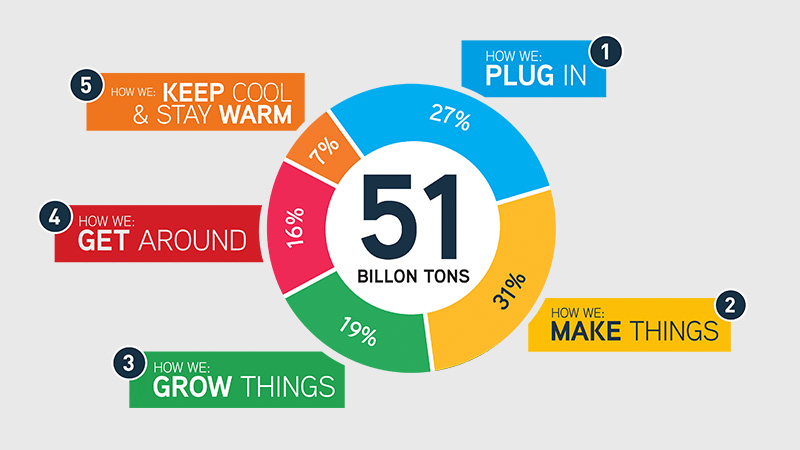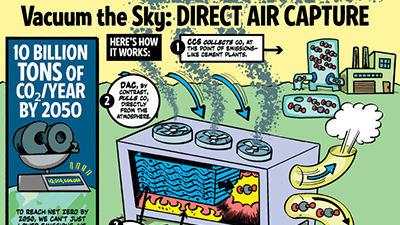Decarbonization Solutions
Driving Question: How can we reduce emissions?
There are numerous solutions to reduce emissions in each of the Grand Challenges, but not all solutions are equal when it comes to avoiding the worst impacts of climate change. How will decision-makers in different communities and countries know where to focus energy, time, and resources? This lesson explores how we can evaluate solutions to maximize their impact and what we can do to get them into widespread use.
Learning Objectives:
- Evaluate decarbonization strategies.
- Identify the solutions most valuable to emissions reduction.
- Research a decarbonization strategy and advocate for its implementation.
Vocab Terms:
- carbon capture and sequestration (CCS)
- decarbonization
- direct air capture (DAC)
- hydroelectric power
- nuclear energy
- renewable energy
Opener: Decarbonization Solutions
To teach this lesson step, refer to page 2 of Lesson 4.2 Teaching Guide.
What are the solutions for reducing emissions? These images will help you think about the most promising decarbonization strategies.
Reducing Emissions
To teach this lesson step, refer to page 3 of Lesson 4.2 Teaching Guide.
Check out our Reading Guide to learn about the Three Close Read approach.
There are lots of options out there that might help decarbonize. How do we determine which ones are worth our time and resources? Read the article to learn more, and then use the activity to decide for yourself.
-
Guiding Questions
-
Before you read
Preview the questions below, and then skim the article. Be sure to look at the section headings and any images.
While you read
Look for answers to these questions:
- Why do solutions in one Grand Challenge have to account for emissions in other Grand Challenges?
- What does it mean to say that a type of energy production is “scalable”?
- Why are air conditioners such a big concern?
- What are the three criteria the article recommends we use to evaluate solutions?
- Who does the article identify as the types of people and groups that can implement solutions?
After you read
Respond to this question: Can you think of any criteria beyond time, cost, and impact potential that we should use to evaluate solutions? Why?
Can We Capture Emissions?
Use AI to check student blind spots:
- First, they research and write their answers using class materials—no AI allowed.
- Then, prompt ChatGPT to generate a pros and cons list of the technology. Challenge students to reflect on what they might have missed or misunderstood.
- Wrap up with a class discussion: Did the AI offer new insights? How did its response compare to theirs in depth, accuracy, and perspective?
Expensive, complex, and…necessary? Use the infographic to explore for yourself the pros and cons of carbon capture, and then synthesize your thinking as you work through the activity.
-
Guiding Questions
-
Before you read
Preview the questions below, and then skim the full infographic, paying attention to things like prominent colors, numbers, charts, and types of text. How do you know where to start and in which direction to read? How do you know which numbers are most important? What concept is the focus of the graphic?
While you read
Look for answers to these questions:
- How much carbon dioxide needs to be removed from the atmosphere every year to reach net zero by 2050?
- How does CCS technology work?
- How does DAC technology work?
- How much time will DAC need to start making an impact?
- What is the cost of DAC relative to CCS?
- What is the impact potential of DAC?
After you read
Respond to this question: Do you think DAC is a valuable solution that should be pursued? Why or why not?
Can We Make Electricity Without Fossil Fuels?
Teaching climate in your social studies class and want to learn more about the history of our energy systems? Check out these Industrial Revolution resources from OER Project: Big History.
Electricity makes our modern lives possible—but can we make electricity without fossil fuels?
-
Guiding Questions
-
Before you watch
Preview the questions below, and then review the transcript.
While you watch
Look for answers to these questions:
- What is the IPCC?
- Why has the Kyoto Protocol largely been considered a failure?
- What is the Paris Agreement?
- Why is the Stockholm Declaration significant?
- Why was the Montreal Protocol considered successful?
- Why is the Kigali Amendment significant?
After you watch
Respond to this question: What do you think are the most important factors that have made climate policies successful?
Key Ideas
Investigating Decarbonization Solutions
To teach this lesson step, refer to page 8 of Lesson 4.2 Teaching Guide.
Check out this blog post – Researching BIG thorny problems – for insight on how to help students figure out effective solutions to climate change.
Dive deep into a single decarbonization solution. Could it be what we need to make a true impact solving climate change?
Closer: Decarbonization Solutions
To teach this lesson step, refer to page 10 of Lesson 4.2 Teaching Guide.
You’ve learned all about the Grand Challenges and their solutions. Now you make the call: Which ones are the most important?
Assessment: Climate Solutions
Human vs. Robot: Climate Solutions Showdown
- Rather than debating each other, students take on an AI opponent. First, they prepare the traditional way—researching, gathering evidence, and building arguments without AI assistance.
- Then, they prompt the AI to debate them on their chosen climate topic. Their challenge: Fact-check the AI in real time and evaluate the quality and creativity of its reasoning.
- Wrap up with a class discussion: Did the AI present strong arguments? Did it challenge or deepen student thinking?
This writing assessment is an opportunity for you to showcase what you’ve learned in this unit by analyzing documents and creating an argument about the solutions needed to reduce emissions.








